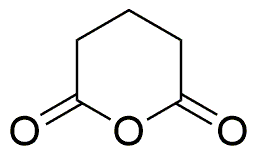Glutaric anhydride is widely utilized in research focused on:
- Polymer Production: It serves as a key monomer in the synthesis of various polymers, enhancing properties like flexibility and durability, making it valuable in the plastics industry.
- Pharmaceuticals: This compound is used in the production of certain pharmaceuticals, particularly in the synthesis of active pharmaceutical ingredients (APIs), which can lead to more effective medications.
- Food Industry: It acts as a food additive and preservative, helping to improve the shelf life and safety of various food products.
- Adhesives and Sealants: Glutaric anhydride is employed in formulating adhesives and sealants, providing strong bonding capabilities and resistance to environmental factors.
- Research Applications: In laboratories, it is used as a reagent in organic synthesis, facilitating the development of new compounds and materials, which is crucial for innovation in chemical research.
General Information
Properties
Safety and Regulations
Applications
Glutaric anhydride is widely utilized in research focused on:
- Polymer Production: It serves as a key monomer in the synthesis of various polymers, enhancing properties like flexibility and durability, making it valuable in the plastics industry.
- Pharmaceuticals: This compound is used in the production of certain pharmaceuticals, particularly in the synthesis of active pharmaceutical ingredients (APIs), which can lead to more effective medications.
- Food Industry: It acts as a food additive and preservative, helping to improve the shelf life and safety of various food products.
- Adhesives and Sealants: Glutaric anhydride is employed in formulating adhesives and sealants, providing strong bonding capabilities and resistance to environmental factors.
- Research Applications: In laboratories, it is used as a reagent in organic synthesis, facilitating the development of new compounds and materials, which is crucial for innovation in chemical research.
Documents
Safety Data Sheets (SDS)
The SDS provides comprehensive safety information on handling, storage, and disposal of the product.
Product Specification (PS)
The PS provides a comprehensive breakdown of the product’s properties, including chemical composition, physical state, purity, and storage requirements. It also details acceptable quality ranges and the product's intended applications.
Certificates of Analysis (COA)
Search for Certificates of Analysis (COA) by entering the products Lot Number. Lot and Batch Numbers can be found on a product’s label following the words ‘Lot’ or ‘Batch’.
*Catalog Number
*Lot Number
Certificates Of Origin (COO)
This COO confirms the country where the product was manufactured, and also details the materials and components used in it and whether it is derived from natural, synthetic, or other specific sources. This certificate may be required for customs, trade, and regulatory compliance.
*Catalog Number
*Lot Number
Safety Data Sheets (SDS)
The SDS provides comprehensive safety information on handling, storage, and disposal of the product.
DownloadProduct Specification (PS)
The PS provides a comprehensive breakdown of the product’s properties, including chemical composition, physical state, purity, and storage requirements. It also details acceptable quality ranges and the product's intended applications.
DownloadCertificates of Analysis (COA)
Search for Certificates of Analysis (COA) by entering the products Lot Number. Lot and Batch Numbers can be found on a product’s label following the words ‘Lot’ or ‘Batch’.
*Catalog Number
*Lot Number
Certificates Of Origin (COO)
This COO confirms the country where the product was manufactured, and also details the materials and components used in it and whether it is derived from natural, synthetic, or other specific sources. This certificate may be required for customs, trade, and regulatory compliance.


